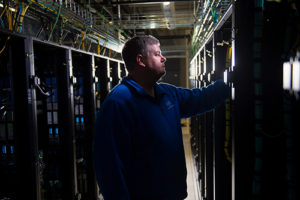What if access to more computing power, data and software were no longer a problem?
Advances in computing power and data storage are two developments that have brought us to where we are today: carrying around smartphones more powerful than the on-board computer that sent Apollo 11 astronauts to the moon, with enough memory for 12,000 books. Yet, developers often hit a wall with modern-day, on-site computing performance, data-flow speeds and hardware limitations.
What if access to more computing power, data and software were no longer a problem? Surgeons living in Dallas could remotely perform surgeries in operating rooms on the polar opposite end of the Earth. Devices could gauge your physical and mental condition and alter the performance of your phone (or other device) accordingly. Entire virtual battleships — right down to their individual components — could be conjured into cybernetic existence.

That’s what Suku Nair — director of the SMU AT&T Center for Virtualization — his colleagues and industry partners are working on. Aside from AT&T, Nair is collaborating with Google, Ericsson and L3Harris on a number of projects.
Virtualization, simply put, is the creation of devices, machines and systems in software, resulting in simulated, yet real-world, behavior. Nair says the center is currently working on virtual solutions that would impact the telecom industry, for enterprise applications (such as the surgical example above) and for improved user experiences. Virtualization is already occurring at SMU at the university level — Nair is working with scientists and PhD students across the campus.
According to Nair, some of the MORE notable projects of the Center include:
The Virtualization of Communications
Telecom companies — in general — are working with virtualization to make their networks more efficient, adaptive and durable. Currently, many networks are set up with a large, complex system of routers and switches that make the decisions for connections. Virtualization – directing the intelligence and software to the cloud would create software-defined networks. Such capabilities will likely be essential for the successful deployment of 5G networks.
In days past, telecoms built networks by dispatching trucks every few months or years packed with replacement switches, routers, etc. It was laborious and slow.
“We don’t have that luxury anymore,” Andre Fuetsch, president, AT&T Labs, and chief technology officer at AT&T, said during the 2016 launch of the center. “We’re virtualizing those specialized network appliances and turning them into software running on servers and other standard hardware. You can add, shift and upgrade capabilities at internet speed. It’s the future, and this new AT&T Center for Virtualization will help us get there faster.”
Augmented and Virtual Reality (AR/VR)
Virtual reality and augmented reality are becoming ubiquitous, turning up in classrooms, theaters and even at jobsites for employee training. SMU’s advanced videogame development program Guildhall is collaborating with the Virtualization Center to develop software and to speed up networking performance, with the goal of creating a high-quality VR/AR experience.
Creating “Aware” Systems
While the center is focusing on applications of tech involving cybersecurity, software, machine learning, algorithms, etc., Nair says researchers are also developing solutions to specific
problems and situations.
For example, if a device can tell its user is operating at less-than-peak capacity — Nair cites an example of a person’s fatigue — their device performance will change to meet those needs.
“You might be looking at an app on your phone screen,” Nair says. “We will look at the dimensions of your pupils, and based on the input, we can change the interface for you. If you’re up to your full potential, you’ll see all the bells and whistles — or fewer.”
Another example Nair cites is that if a device detects someone behind its user, the device’s screen might autonomously darken, to hide the data from prying eyes. What, if anything,
might limit virtualization?
“Obviously performance [in the speed of data flow] is a key requirement when we try to mimic reality,” Nair says. “We need to figure out which part of the virtualization takes priority. For example, if the DoD [Department of Defense] wants to build digital twins [of hardware]with identical behavior,” he says. “A ship is a complex system. How do you virtualize all of [the ship’s workings] at the same time? It becomes a big problem.”
This article is part of the 2020 Higher Education Review Magazine.